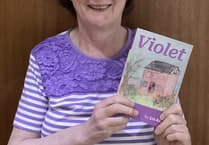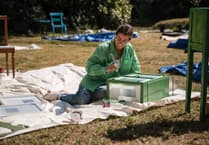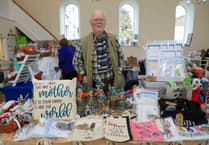Instead of her signature turquoise silk outfit, she wore purple, white and green, the colours of the Suffragette movement.
Ella had a long career with the BBC and the focus of her talk was her involvement in the making of a TV series screened in the 70s, which dramatised the lives of the Pankhurst women and their role in the Suffragette movement.
She was working in the plays department when she was appointed production unit manager for a six-part drama series called ’Shoulder to Shoulder’, based on a book by Midge Mackenzie.
The series was produced by Verity Lambert and starred Sian Phillips as Emmeline Pankhurst and Patricia Quinn as Christabel.
Other leading roles were played by Angela Down, Michael Gough, Robert Hardy, Fulton Mackay, Georgia Brown and Judith Parfitt who is still acting in ’Call the Midwife’.
Locations included the House of Commons and Caxton Hall, where Mrs Pankhurst addressed hundreds of women.
Horses and carriages were employed, streets were disguised with rubber cobbles, and leaves were used to cover double yellow lines.
Composer Stanley Myers wrote an arrangement of Dame Ethel Smyth’s ’March of the Women’ for the opening titles:
’The budget was tight so we employed a few professional singers - and all the production team who thought they could sing joined in. If you listen very carefully (on YouTube) you might hear my voice among the sopranos.’
One of the moments which particularly stuck in her mind was the recording of the forced feeding in the prison scenes.
’Sian Phillips insisted on doing it properly and they had to have a doctor and nurse standing by,’ she said.
’It was a horrible procedure, either putting a hose down the prisoner’s throat or tubes into the nose. The authorities didn’t want anyone to die so prisoners were sent home to recover and then they had to return at a later date to go on their hunger strike again.’
A century on, she wondered what Mrs Pankhurst and her colleagues would think about the position of women in society today, after they struggled so hard to get the vote for women. While in London recently she had seen preparations being made for the unveiling of a statue of Suffragette Millicent Garrett Fawcett and on December 14 a statue of Emmeline Pankhurst will be unveiled in Manchester.
’Let’s hope it will not be too long before our statue of Sophia Goulden and Emmeline will be unveiled in Laxey’, she concluded.
Sophia Goulden, nee Craine, was born in Lonan in 1833. Her family later moved to Douglas and established a boarding house where Sophia met her future husband Robert Goulden from Manchester, where they moved after their marriage. She was an activist, fighting for many causes including the abolition of slavery, and was an ardent supporter of universal suffrage, believing in the right of all adults to vote.
She took her two eldest daughters, Emmeline and Mary to ’Votes for Women’ meetings and encouraged all ten of her children to fight for women’s right.
We know Emmeline by her married name Pankhurst. In her book ’My Story’ she acknowledged her mother as being her inspiration.




